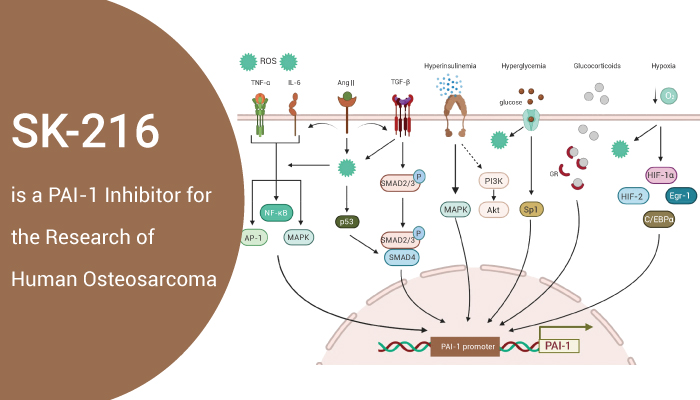PAI-1 (plasminogen activator inhibitor-1, also known as SERPINE1) is a member of the serine protease inhibitor (SERPIN) family and is the primary inhibitor of two major mammalian plasminogen activators (urinary (uPA) and tissue (uPA)). tPA). Firstly, it is an important factor in regulating the physiological balance between thrombosis and fibrinolysis. Secondly, PAI-1 is an unstable molecule that exists in four different forms: active, potential, cleaved, and target-bound. Importantly, PAI-1 also plays a role in cell migration, adhesion, aging, cancer invasion, and tissue remodeling. It is also one of the plasma biomarkers associated with nonalcoholic fatty liver disease. These associations make PAI-1 an attractive drug target.

SK-216 is a PAI-1 inhibitor for the research of human osteosarcoma.
SK-216 is a plasminogen activator inhibitor-1 (PAI-1) inhibitor that acts as an anti-metastatic agent for human osteosarcoma and inhibits lung metastasis of human osteosarcoma. In some in vitro studies, SK-216 (0-50 μM, 48 h) can inhibit the invasion of 143B cells in a dose-dependent manner. But it does not affect cell proliferation and migration. It inhibits PAI-1 expression by 40% at concentrations of 25 and 50 μM and leads to a significantly lower ratio of cell-invaded wells/total wells. Besides, it inhibits MMP-13 secretion in 143B cells. In some in vivo studies, SK-216 (i.p., 6.6 μg/200 μL in PBS, every 3 days) inhibits lung metastasis of human osteosarcoma cells in a male athymic nude mouse model infected with 143B-Luc cells but failed to inhibit tumor growth at the primary site. Moreover, it results in a significant reduction in PAI-1 expression levels in primary lesions in mice.
In conclusion, SK-216, a PAI-1 inhibitor, acts as an antimetastatic agent in human osteosarcoma and inhibits lung metastasis of human osteosarcoma.
Reference:
[1] Minori Tsuge, et al. Int J Mol Sci. 2018 Mar 5;19(3):736.
[2] Matteo Cesari, et al. Cardiovasc Ther. 2010 Oct;28(5):e72-91.